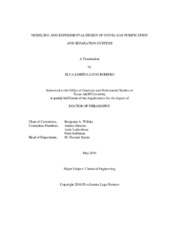| dc.description.abstract | The purpose of this work is to address the current challenges of reaction-assisted gas purification systems and gas separation membranes via segregated structuring of multiple reaction, separation, and/or material functionalities in a single unit. Initial focus is on the challenges faced by packed-bed membrane reactors (PBMR) such as film corrosion and competitive adsorption. Firstly, a novel multifunctional reactor design employing a composite catalytic-permselective membrane is introduced. In this design, a permselective film is integrated with a porous catalytic layer for converting CO and H2O into CO2 and H2 via the water-gas shift reaction. This sequentially structured integration of the catalytic and separation functionalities has proven capable of replacing PBMRs while improving film utilization and enhancing the reaction product yield.
Next, the production of high-purity H2 via sorption-enhanced reforming process (SERP) is presented. SERPs combine CO2-adsorption with catalytic reaction in a fixedbed admixture of adsorbent and catalyst particles. The removal of CO2 from the bulk fluid enhances H2 yield, purifies H2 product, and captures CO2 for controlled disposal. However, bed-scale dilution of CO2 partial pressure limits sorption rates, while intraparticle diffusional limitations restrict catalyst utilization. These challenges can be addressed using a multifunctional catalyst design coupling adsorptive and catalytic functionalities at the particle scale to yield synergetic enhancement of reaction and adsorption rates. This work presents a side-by-side comparison of the two leading multifunctional catalyst designs reported in the literature for SERPs: the core-shell design and the uniform-distributed design.
Finally, attention is given to the characterization of Layer-by-Layer (LbL) polymeric films for gas separation and gas barrier applications. The LbL technique allows the integration of multiple distinct material and/or structural properties to achieve novel membranes with better separation and barrier performance than any of the individual constituent materials. Initially, a highly flexible polymer-clay coating with extremely low H2 and He permeabilities is presented. This barrier coating would allow size and weight reduction for He/H2 storage and transportation equipment. Then, an all-polymer film for CO2/N2 separation is introduced. The use of membranes to selectively remove CO2 from mixtures with N2 is of interest for the application in flue gas rectification. | en |


